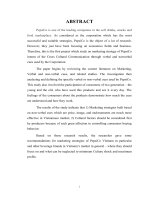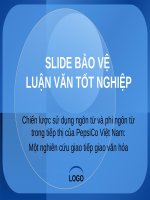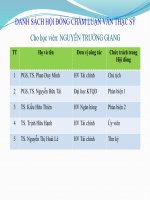SLIDE bảo vệ LUẬN văn tốt NGHIỆP CHIẾN lược sử DỤNG NGÔN từ và PHI NGÔN từ TRONG TIẾP THỊ của PEPSICO VIỆT NAM một NGHIÊN cứu GIAO TIẾP GIAO văn hóa
Bạn đang xem bản rút gọn của tài liệu. Xem và tải ngay bản đầy đủ của tài liệu tại đây (1.12 MB, 41 trang )
LOGO
SLIDE BẢO VỆ
LUẬN VĂN TỐT NGHIỆP
Chiến lược sử dụng ngôn từ và phi ngôn từ
trong tiếp thị của PepsiCo Việt Nam:
Một nghiên cứu giao tiếp giao văn hóaStrategic use of verbal and non-
verbal cues in marketing by
PepsiCo Vietnam: A study of Cross
Cultural Communication
Chiến lược sử dụng ngôn từ và phi ngôn từ
trong tiếp thị của PepsiCo Việt Nam: Một nghiên
cứu giao tiếp giao văn hóa
Contents
Part A: Introduction
Part B: Development
Part C: Conclusion
Introduction
Rationale
In modern economy, marketing plays an increasingly
important part.
Almost all major corporations are actively involved in
marketing their products beyond their original homeland
borders The main challenge in globalization age: the
cross cultural marketing and how to do it.
The researcher:
Having a high personal interest in PepsiCo’s products and their
successful marketing strategy
being a double-major student – who can work both in economic
and language fields
provide an in-depth understanding of the Strategic use of
verbal and non-verbal cues in their marketing activities.
get the knowledge for the future job
Aims
Knowing how successful the marketing strategies of
PepsiCo is , the researcher carried out the study with the
aims:
To find out what are strategies which include verbal and non-
verbal cues
To find out how Pepsi uses those in their marketing strategies to
attract Vietnamese customers.
To hope to propose some suggestions for others companies
Research questions:
What are the
marketing
strategies of
verbal and non-
verbal cues and
How PepsiCo
Vietnam uses
them?
2 research
questions
What are the
attitudes of
Vietnamese
consumers
toward the
strategies?
Methodology
1
Data collection
instruments
1.Case Study
2.Questionnaire
2
Data collection
procedures
Phase 1: Preparation
Phase 2:
Disseminations of
questionnaires
3
Data analysis
methods and
procedures
Development
Development
Chapter 1: Literature review and
Theoretical background
Literature review
PepsiCo is the object of many studies:
“Pepsi across cultures: analysis and cross-cultural
comparison of Pepsi websites” by Alexandra Chirkova
‘PepsiCo: International Marketing Report’ -
Benedictine University (Chicago, 2009)
Marketing plan on PepsiCo in Pakistani market (2009)
– Comsats institute of information technology
Pepsi Marketing Report – Muhammad Umair Sheikh
(2011)
this study is not overlapped with anyone,
anything.
Theoretical background
Verbal and non-verbal cues
Verbal Cues
something that you
can figure
someone out
based on what they
said, or how they
said it
Non-verbal Cues
includes “all the
communication between
people that do not have a
direct verbal translation.”
3 main elements of nonverbal
cues: appearance, body
language, sound
Theoretical background
Marketing and Marketing Strategies
Marketing: a bridge from the producer to the consumer.
Marketing strategy: the result of decisions which are
made about how a particular product or service will be
promoted to its target customers.
Marketing strategy activities:
Theoretical background
Verbal and non-verbal cues in marketing
Verbal cues
•
Slogans
•
Songs
•
Promotion campaigns (oral
advertising)
Non-verbal cues
•
Image of the product
(design)
•
Images used in advertising
•
Price
•
Location
Development
Chapter 2: Strategic use of verbal and
non-verbal cues in marketing by
PepsiCo Vietnam
PepsiCo
PepsiCo: a world leader in convenient snacks, foods and
beverages
PepsiCo Vietnam was established in February 1994,
when the US Embargo to Vietnam was lifted marking the
phenomenal entrance of PepsiCo into this new market
The company’s diverse product portfolios: Pepsi Cola,
7Up, Mirinda, Aquafina, Sting, Twister, Lipton Ice Tea,
Poca
Verbal cues used by PepsiCo
Slogans
Pepsi strongly impresses consumers with their slogans –
which is youngsters targeted and easy to remember
The slogan of Pepsi always stick to the young
throughout periods
Some favorite slogans over years:
1961-1963: "Now It's Pepsi for Those Who Think Young"
1984–1991: "Pepsi. The Choice of a New Generation"
1997–1998: "Generation Next"
2006–2007: “Taste the one that's forever young"
Verbal cues used by PepsiCo
Songs
Music has become an important part of the marketing
tool’s scope, can serve the overall promotional goals in
one or more of several capacities
Some of the most famous songs:
In 1938, Pepsi 12-ounce with the song “Nickel, Nickle” which
immediately became popular & was covered in 55 languages.
In 1964, Diet Pepsi with the unique song “Girlswachers” – one of
the top 40 hit songs
“Pepsi-Cola Hits The Spot” – the immortal song
In every advertisement, the theme music always are
exciting song contributing to build up the impression of a
product for young people of Pepsi
Non-verbal cues used by PepsiCo
Design
Color: can have an impact on our body and mind.
Color chosen has to be:
most represents the features of the brand
opposite the color of the competitor
Toward some culture, the choice of right color is the key
of success.
Chinese & Vietnamese people: prefer red
Thai and Japanese people: prefer blue
Non-verbal cues used by PepsiCo
Design
Packaging:
Pepsi can is designed light, portable
Every used cans are collected or rebought by the
Corporation and then recycled.
Pepsi sends a message to consumers that they do not
only concern about benefits but also healthy and
environment.
makes Pepsi particularly become an environment-friendly
brand in the eyes of consumers
Non-verbal cues used by PepsiCo
Endorsements
Pepsi has had many advertising spokespersons over the
years; all of them are very popular singers/stars that
have strong influence to the young & the consumers
Global: Michael Jackson, Britney Spears, Beyoncé Knowles,
Christina Aguilera, Mariah Carey
In Vietnam: My Tam, Anh Khoa, Phuong Vy, Kasim Hoang Vu,
Hong Son, Huynh Duc (football players)
Non-verbal cues used by PepsiCo
Price
Price of PepsiCo is considered reasonable, even
cheaper than other soft drinks in Vietnam’s
market. Together with discount schemes, the
products become more and more popular to
consumers.
The combination of the two
elements
The combination of the two elements is what makes
PepsiCo’s marketing strategies successful.
Reviewing the history of the brand: each logo goes with
particular bottle design
Each promotion campaign goes with a sponsor
Two elements can support each other effectively.
For example:
In 1941, the Pepsi bottle crown colors were changed to red,
white and blue, along with the Pepsi logo, to commemorate the
war efforts of the country.
In 2009, Pepsi introduced Diet Pepsi with the skinny can design
which is a “taller, sassier” version of the traditional ones. It was
for Fashion Week and made in “celebration of beautiful,
confident woman”.









